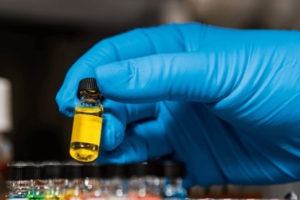- Cell line-derived xenograft (CDX) models offer a ready-to-test platform to screen the efficacy of the oncology discovery test compounds in vivo on standard human cancer cell lines. The ease and shorter timelines involved in these studies (<60 days) enable pre-clinical screening of test compounds within a shorter duration.
- The CDX models are generally studied in immuno-deficient animals, enabling us to understand the tumour development of human cancerous cells without any immunogenic responses from the host. This achieves the screening of the therapeutic effect of the test compounds exclusively in mitigating the disease.
- Immunodeficient mice such as Nude, SCID, NSG, and NRG strains are opted for studying the tumour efficacies.
- Immuno-oncological evaluations to study the tumour infiltrating lymphocytes (TILs) and other immunocytes during tumour development and the anti-tumour therapy can also be studied using humanized mice.
- A vast library of cells based on tissue of origin or mutation type has been used to screen multiple test compounds along with standard drug molecules.
- Deliverables and readouts: Tumour volume, tumour growth inhibition, body weight, clinical signs.
- Timelines: 50-60 days (total in-life phase)
In vivo oncology: Cell line derived xenograft (CDX) models
| Tumour type | Cell line | Origin | Test species | Model type |
|---|---|---|---|---|
| Brain | U87-MG | Human | Mouse | Subcutaneous & Orthotopic |
| U251 | Human | Mouse | Subcutaneous | |
| Breast | MCF-7 | Human | Mouse | Subcutaneous |
| MDA-MB-231 | Human | Mouse | Subcutaneous & Orthotopic | |
| MDA-MB-468 | Human | Mouse | Subcutaneous | |
| Bladder | T24 | Human | Mouse | Subcutaneous & Orthotopic |
| 5637 | Human | Mouse | Subcutaneous | |
| TCCSUP | Human | Mouse | Subcutaneous | |
| UMC-1 | Subcutaneous & Orthotopic | |||
| UMC-14 | Subcutaneous & Orthotopic | |||
| RT-112 | Orthotopic | |||
| Colon | HCT116 | Human | Mouse | Subcutaneous & Orthotopic |
| DLD1 | Human | Mouse | Subcutaneous | |
| SW480 | Human | Mouse | Subcutaneous | |
| HT29 | Human | Mouse | Subcutaneous & Orthotopic | |
| COLO-205 | Human | Mouse | Subcutaneous | |
| Epidermoid (skin) | A431 | Human | Mouse | Subcutaneous |
| Gastric | N-87 | Human | Mouse | Subcutaneous |
| Head & Neck | CAL-27 | Human | Mouse | Subcutaneous |
| HEp-2 | Human | Mouse | Subcutaneous | |
| Lung | A549 | Human | Mouse | Subcutaneous, Orthotopic & Disseminated |
| H1975 | Human | Mouse | Subcutaneous | |
| NCI-H460 | Human | Mouse | Subcutaneous | |
| NCI-H441 | Human | Mouse | Subcutaneous | |
| NCI-H23 | Human | Mouse | Subcutaneous | |
| NCI-H727 | Human | Mouse | Subcutaneous | |
| PC-9 | Human | Mouse | Subcutaneous, Orthotopic & Disseminated | |
| Liver | HepG2 | Human | Mouse | Subcutaneous |
| SNU-398 | Human | Mouse | Subcutaneous | |
| JHH-7 | Human | Mouse | Subcutaneous | |
| Melanoma | A375 | Human | Mouse | Subcutaneous |
| Multiple myeloma | NCI-H929 | Human | Mouse | Subcutaneous |
| Medulloblastoma | D283 | Human | Mouse | Subcutaneous |
| Kidney | ACHN | Human | Mouse | Subcutaneous |
| Pancreas | BX-PC3 | Human | Mouse | Subcutaneous & Orthotopic |
| MIA PaCa-2 | Human | Mouse | Subcutaneous & Orthotopic | |
| Prostate | DU145 | Human | Mouse | Subcutaneous |
| PC-3 | Human | Mouse (huNOG-EXL) | Subcutaneous | |
| Pro-B cell line | Ba/F3 | Mouse | Mouse | Subcutaneous |
| LNCaP | Human | Mouse | Subcutaneous | |
| Ovarian | SKOV-3 | Human | Mouse | Subcutaneous |
| PA-1 | Human | Mouse | Subcutaneous | |
| OVCAR-3 | Human | Mouse | Subcutaneous | |
| OV-90 | Human | Mouse | Subcutaneous | |
| Osteosarcoma | SJSA-1 | Human | Mouse | Subcutaneous |
| Retinoblastoma | Y79 | Human | Mouse | Subcutaneous |
| Chronic myeloid leukaemia (CML) | K562 | Human | Mouse | Disseminated |
| Acute myeloid leukaemia (AML) | KG-1 | Human | Mouse | Disseminated |
| Kasumi-3 | Human | Mouse | Disseminated |











